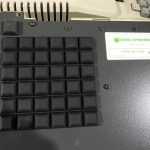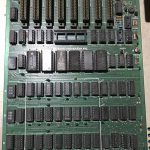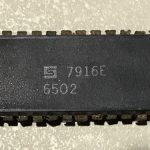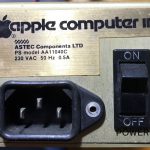Well, at least I was able to follow through with my final list of to-dos!
- I gathered together like screws into ziplock bags! An easy win for progress!
- I cracked open the remaining three PSUs! “Pro” Tip*: after drilling the head off the rivet, be sure to push the remaining rivet body into the case so the PSU baseplate can be removed (I found a Torx 8 screwdriver head worked well for this) – once the base is removed you can easily pop the rivet bodies all the way through the rest of the case sides (T8 to the rescue again) to remove them. *If you hadn’t noticed, I’m not really a “Pro”.
- There’s a very clear winner in the “Solvent Most Likely to Clean Off Apple ][ europlus Rubber Foot Adhesive Gunk After 35+ Years Stakes”, and that winner is methylated spirits (locally known as “metho” [“Australia: the land of nicknames for everything” should be our national slogan]). Isopropyl alcohol didn’t do anything, and I worried that the gunk would get the best of me and my alcohol-fuelled (well, “alcohol-based”, anyway) attempts to rid myself of it – see the pictures below for some before and afters. This is especially happy news as I have a 20L drum of methylated spirits in the Man Cave, so I shouldn’t run out when it comes to cleaning all the gunk off all the bases!
- My second retro-themed Bulgarian purchase, which arrived last Friday, was a2heaven’s Apple II VGA Scaler – an Apple ][ interface card which provides VGA output for the Apple ][, the Apple ][+, the Apple ][ europlus (yay!), and the Apple //e. It supports both PAL (yay again!) and NTSC systems. I’ll write up a separate post on this card as I work through setting it up – I’ve got it basically working on my known good 8237 motherboard, but I have a glitch or two to sort out and I don’t want to get distracted so close to The Finish Line.
- I went back to my original test monitor setup with my known good 8237 motherboard – it all worked and booted into the Dealer Diagnostics disk. So something else was wrong when I tested the next few machines which I’ll leave to another day to try and nail down.
- I’ve returned the donor ROMs and ICs I used while testing motherboards (as reported in my Half Time Report and Little Ray of (Retrochallenge) Sunshine posts). When I do finally get to test my motherboards and swap in components to try and get non-functioning motherboards working, I’ll do a much better job of keeping track of which components I swap to and from where.
- I’ve not had time to think of anything else to add to my to-do list tonight, and it’s uncertain what I’ll get time to do in the morning beyond my final entry post – but at least I got to do tonight what I wanted to get done, so I’m happy about that.
Boy! Do I wish I was able to dedicate many more such sessions of time to my first Retrochallenge 2016/10 entry.
Well, I’ll leave my (not quite) post mortem to my final Retrochallenge post tomorrow morning.












You must be logged in to post a comment.